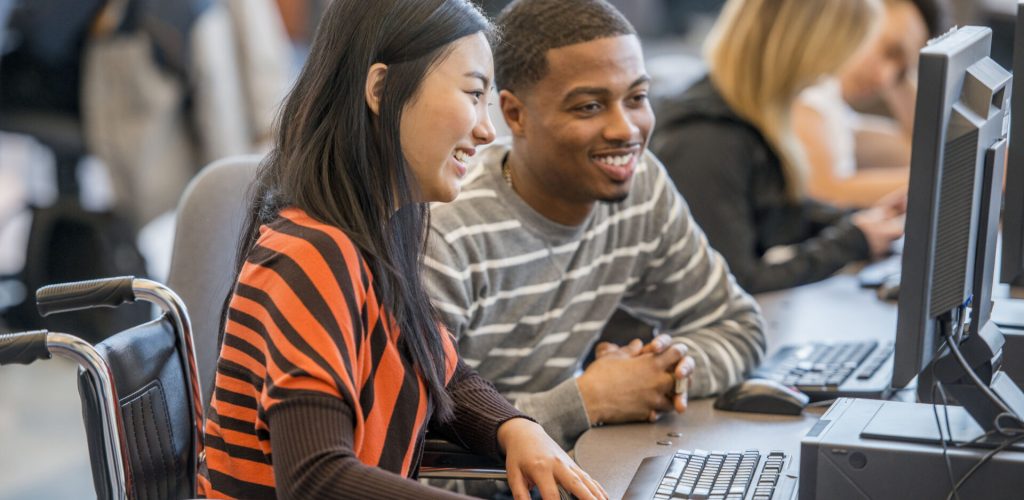ansrsource recently celebrated Global Accessibility Awareness Day by encouraging our teams and our community to think about, learn about, and experience digital accessibility. We honored the occasion by announcing that ansrsource commits to build the infrastructure to allow all of our content to be designed using Universal Design for Learning principles and developed according to accessibility best practices.

According to the Institute on Disability, nearly 19% of the world’s population lives with some form of disability. If formally recognized as a minority group, this would be the largest such group in the United States with 1 in 5 Americans living with a disability. 11% of the U.S. undergraduate post-secondary student population reports having a disability, according to the National Center for Education Statistics, but due to underreporting and an increasingly diverse student body, some estimates put the number as high as one-third of student populations. Within the higher education population, only 34% of students with disabilities complete a four-year program.
Higher education has made great strides to include more diverse students including non-traditional, formal military personnel, and adult students, but in many cases the model continues to assume all students are able-bodied. According to data from the United Nations’ World Population Prospects report, between 2015 and 2030, the number of people in the world aged 60 years or over is projected to grow by 56 percent. Higher education and corporate learning both acknowledge the shifting dynamics of their learners but are now tasked with adapting and scaling existing and new content in a responsible and affordable manner.
Challenges in interacting with online content for people with disabilities include a wide range of possible barriers including but not limited to website color contrasts, missing or inaccurate video transcripts, jumbled content when using a screen reader, features only accessible by using a mouse, and incorrectly uploaded documents such as PDFs. With federal mandates, cuts to funding, complaints and lawsuits, and a population that has been kept at the periphery of higher education, many institutions find themselves utilizing a reactive, not proactive, strategy in addressing accessibility.
Those who build, shape, fund, and influence educational technology generally agree that creating programs focused on usability and access is the right thing to do and understand it is mandated by law, but they often do not know where to start.
We can relate. The challenge is massive. Our university, corporate, non-profit, publisher, and education technology partners are asking for help, but traditional means are not sufficient to address the scale of the problem. And these methods are too expensive. Nobody has the budget to fix centuries-old systems and the physical and virtual libraries of content worldwide using solely manual approaches.
We are committed to helping to solve this problem through our accessibility services. After 15 years of dedication to improving the quality of learning experiences at scale through our relentless focus on content, we are now applying our experience to build new solutions. These solutions include artificial intelligence-enabled accessibility tools allowing our teams to provide the quality of accessibility services learners with disabilities deserve, far faster and at less cost than was previously possible. Our experts will be able to deliver more for less.
May 16, Global Accessibility Awareness Day (GAAD), was a great opportunity to raise awareness and to begin the process of what it will take to fulfill our commitment to incorporate accessibility into everything we do. The founders of GAAD encourage everyone to test at least one page of their site using an accessibility tool. By applying necessary fixes, people can share solutions and inspire others to do the same. Some quick checks suggested include:
- Go mouseless for an hour: Is your keyboard sufficient to interact with every element?
- Enlarge your fonts: Resize to 200% and check content and functionality
- Check your color contrast: Have you used sample groups to check readability? If not, the Paciello Group has you covered with their downloadable Colour Contrast Analyser (CCA)
- Surf the web with a screen reader: Learn basic keystrokes and take an online screen reader for a test drive
- Play with your iPhone or Android: Explore the built-in accessibility features of your phone
- Share your experiences and insights through #GAAD and ansrsource and learn more about GAAD at https://globalaccessibilityawarenessday.org/
People with disabilities face attitudinal, environmental, and institutional barriers daily, but online content is one potential area of reprieve. Beyond the realm of higher education, increasing access to technology and online content increases access to society, careers, and engaging in commerce. Desmond Tutu once explained as the spirit of Ubuntu, I am because we are. Weaving accessibility into all content will strengthen our interconnectedness and the associated global impacts. Promoting and protecting the rights and dignity of all lifelong learners is just one way ansrsource is seeking to accelerate better ways to learn for all.



